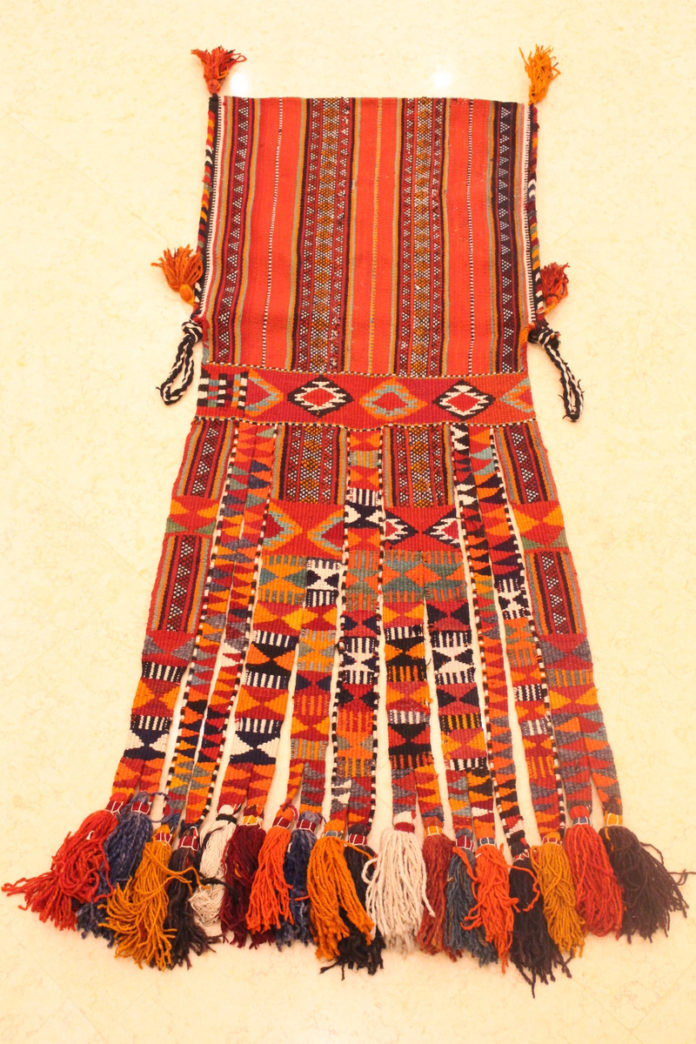Al-Sadu weaving is a women’s handicraft practiced mostly by the Bedouin (nomad) women of the State of Kuwait. The name of this craft originates from the Arabic word “Sada”, which means to extend. As a term “Al-Sadu” refers to: 1) the name of this craft’s traditional floor loom, 2) textiles produced on the Al-Sadu loom and 3) the Al-Sadu weaving technique.
This craft is well known among the Bedouins of Kuwait and the Arabian Gulf countries, as well as, Arab countries such as Iraq, Jordan and Syria. Sheep wool, goat hair, camel hair, and cotton yarns are the four natural fibres used in Al-Sadu weaving. Only white wool is coloured with natural substances such as alum, dried lime, henna, madder and safflower. Lately, chemical dyes are heavily in use due their low prices and fast results.
The flat weave warp-face technique is the commonly practiced one. Its end products are used to build the traditional Bedouin tent (Bait-al-Shaar), as well as making tent dividers (qatta), pillowcases, area rugs (bisat), saddle bags (khraj), handbags (mizwadah), storage bags (adel), blankets (lihaf). Also, many decorative items are created with this craft to enhance the looks of Bedouin tents, camels, horses and camel litters (hodaj) which are used by women when traveling.
Al-Sadu hand craft is taught to Bedouin girls at an early age. They start by helping their elderly, and as they grow up they weave themselves. The basic and simple Al-Sadu motifs taught to young weavers are the border and semi-border motifs such as Hubub seeds, Dealla ribs, Eein eye, Dhurs El Khail horse teeth and Uwairjan lines of triangles facing each other. Later, the young weaver is taught the advanced motifs that are placed in the long central pattern which is called the shajarah or tree which consists of a collection of motifs. When mastering weaving the shajarah, the young weaver is recognized as thafrah or victorious .
The traditional Bedouin tent betasharr (house of hair) is no longer made. Sadu weaving is still active in Sadu House, Kuwait City, and in private homes.
Further reading
Al-Sabah, Altaf S.A. (2006) Ibjad: Ornate Tent Dividers and Weavings of the Kuwait Desert. Al-Assriya Printing Press Pub. And Dist. Co., Kuwait.
Canavan, K. & Alnajadah, A. (2011) “The association between Bedouin Al-Sadu weaving and the camel”. Camel Culture conference paper, SOAS, London, UK.
Canavan, K. & Alnajadah, A. (2013, July) Material Symbols of Traditional Bedouin Al-Sadu Weavings of Kuwait. Textiles: the journal of cloth & culture. (Vol.11, No. 2, pp. 152-165).
Crichton, Anne-Rhona (1998, 2nd ed.) Al Sadu: The Techniques of Bedouin Weaving. ALSADU Weaving Cooperative Society, Kuwait.
-1) A small Sadu floor loom built with metal pipes for training purposes. Picture is taken at the Al-Sadu Weaving Cooperative Society.
-2) Al-Sadu weaving yarns, spindle, and white sheep wool. Picture is taken at the Al-Sadu Weaving Cooperative Society.
3) Long Sadu area rug. Kuwait National Museum 001-4) Sadu decoration piece. Kuwait National
Museum








I am impressed to learn the activities of Al- Sadu handicraft which are very important for livelihood of weavers and Bed0uin community. Beside many woolen product of hand craft ,there are other use of coarse wool from Naeemi sheep of kuwait i.e Felt etc.